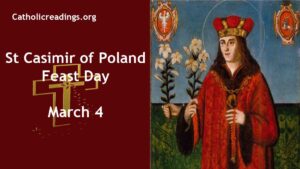St Casimir Jagiellon was a prince born on October 3 1458 in Wawel, Kraków, Poland, and died on March 4 1484 at the age of 25 in Grodno, Lithuania in modern-day Belarus.
We celebrate his feast day on March 4 every year in the Catholic Church.
St Casimir is the Patron Saint of Lithuania and the Lithuanian youth.
| St Casimir of Poland Biography | |
|---|---|
 St Casimir of Poland – Feast Day – March 4 2026 | |
| Date of Birth | October 3 1458 |
| Place of Birth | Wawel, Kraków, Poland in Europe |
| Profession | Prince of Poland |
| Place of Work | Poland |
| Date of Death | March 4 1484 (aged 25) |
| Place of Death | Grodno, Lithuania in modern-day Belarus |
| Feast Day | March 4 |
| Canonization | By Pope Adrian VI in 1522 |
| Patron Saint of |
|
St Casimir Life History
St. Casimir was born in the royal palace at Cracow, Poland on October 3 1458, as the third child and the second son among the thirteen children of King Casimir IV and Elizabeth of Austria, who was the daughter of Albert II of Habsburg.
Under the guidance of his virtuous mother, from the age of nine, St. Casimir and his brother Vladislaus received their education from a Polish priest named Fr. John Dlugosz.
He was inspired from an early age by the teachings and actions of his mentors, and this led him to develop a strong sense of piety and innocence.
As he grew older, he demonstrated a commitment to living a virtuous life, even to the point of performing heroic deeds.
During his teenage years, St. Casimir led a life of extreme discipline and austerity. He slept on the ground, spent many hours of the night in prayer, and made a commitment to remain celibate for the rest of his life.
When the nobles in Hungary became dissatisfied with their king, Matthias Corvinus, they requested St. Casimir’s father, the king of Poland, to send his 15-year-old son to take over the country.
St. Casimir obeyed his father’s order, although his army was outnumbered and some of his troops had deserted due to non-payment. Upon the advice of his officers, he decided to return home, which irked his father.
As a result, he was confined for three months. This experience made him vow to never again participate in the wars of his time, and even under pressure to marry the emperor’s daughter, he remained committed to his decision to remain celibate and dedicated to prayer and study.
In 1479, his father, the king of Poland, travelled to Lithuania to attend to state matters, leaving him in charge of the kingdom from 1481 to 1483.
St. Casimir began experiencing symptoms of tuberculosis and foresaw his imminent death. He prepared for his passing by intensifying his devotion to God.
He died while travelling to Lithuania on March 4, 1484, in Grodno. His body was laid to rest in Vilnius Cathedral in Lithuania, where Saint Casimir’s Chapel was constructed in 1636 in his honour.
St. Casimir was believed to have performed one of his first miracles during the Siege of Polotsk in 1518. He allegedly appeared before the Lithuanian army and showed them a safe crossing point on the Daugava River.
As a result, they were able to relieve the city, which was under siege by the army of the Grand Duchy of Moscow.
Another miracle attributed to St. Casimir was the Lithuanian victory against Russian troops in 1519, who had raided the outskirts of Vilnius.
122 years after St. Casimir’s death, his tomb in the Vienna Cathedral was opened so that his body could be transferred to a new marble chapel.
The place where his remains were kept was damp, and the vault was crumbling in the hands of the workmen.
However, when the body, clothed in silk robes, was discovered, it was found to be whole and uncorrupted.
A sweet fragrance emanated from it, filling the church and refreshing those present. St. Casimir’s hymn book of Our Lady, which he had buried with him, was found beneath his head.
Three young men claimed to have seen a brilliant light emanating from the open tomb the following night, streaming through the windows of the chapel.
Veneration
Shortly after his death, St. Casimir’s official veneration began to spread. In 1501, Pope Alexander VI granted a special indulgence to those who prayed in the chapel where St. Casimir was buried during certain Catholic festivals and contributed to the upkeep of the chapel.
The Pope cited the splendour of the chapel and St. Casimir’s miracles as reasons for granting the indulgence.
Canonization
After Casimir’s death, his brother Sigismund I the Old urged the pope to canonize him during the Fifth Council of the Lateran in 1514.
In November 1517, Pope Leo X appointed a commission to investigate Casimir’s sanctity and sent his legate Zacharias Ferreri to conduct the investigation.
Ferreri completed his work in about two months and published his findings in 1521 as Vita Beati Casimiri Confessoris.
Although the canonization of Casimir seemed imminent, Pope Leo X died in December 1521. Pope Adrian VI canonized him in 1522.
Due to the Protestant Reformation’s criticism of the cult of saints, there were no new canonizations between 1523 and 1588. However, Casimir was eventually included in the first Roman Martyrology published in 1583.
Powered By SEO Experts
Follow @ReadingCatholic
